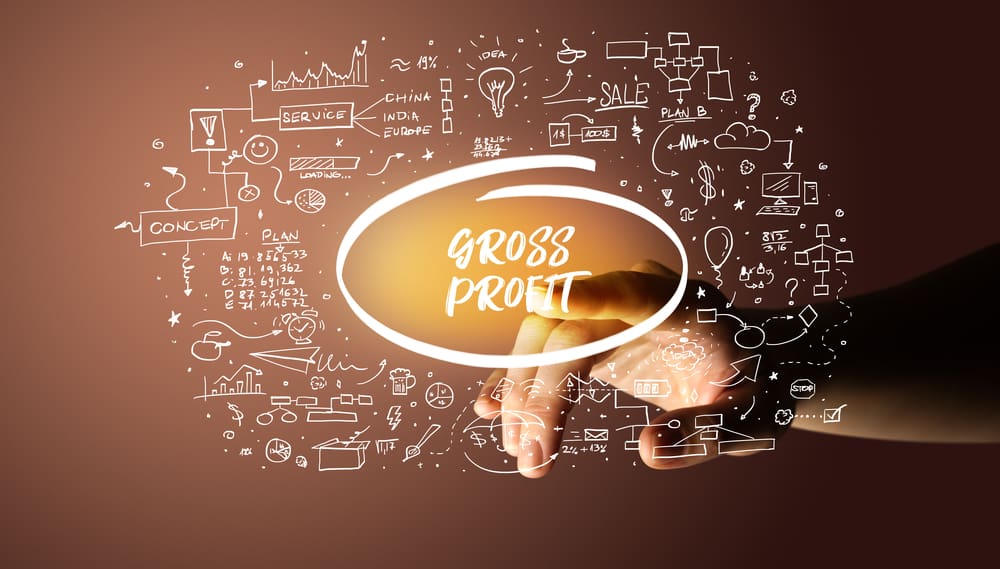What Is Gross Profit? |What Does Gross Profit Tell You? |Gross Profit Vs. Gross Profit Margin | Example Of Gross Profit | Gross Profit Vs. Net Profit |
How To Calculate Gross Profit & Net Profit
Understanding profit is one of the first and most important things any business owner needs to be successful. If you don’t know the differences between different kinds of profit and what each one ultimately means for your business, it can be hard to create a growth strategy that works.
Equally importantly, if you don’t know how the different kinds of profit function and what they mean for your business, you won’t be able to give investors high-quality, accurate information about your business.
At best, not having that information will mean fewer people will be interested in investing. At worst, your investors might not get dividends owed, or your business may assume it has more money available than it does.
You need a solid understanding of what gross profit is, how it works, and what it means for your business if you want to succeed. Fortunately, that’s precisely what this article will give you.
Let’s get started!
[ Thinking about investing in real estate? Register to attend a FREE online real estate class and learn how to get started investing in real estate. ]

What Is Gross Profit?
Gross profit, put simply, is the amount of profit you made in a given period after subtracting the cost of goods sold (COGS) from your total profit for the same period.
This is distinct from just subtracting all your costs and works the same for businesses selling a product and businesses selling a service.
For service-based businesses, you need to subtract the cost of providing the services you sell just like you would subtract the cost of manufacturing or buying the products other companies sell.
Some profits need to be excluded from your calculation of gross profit. The profits you’re counting should only be profits from the sale of your goods and services. If your business, for instance, sold a building you used to operate out of but no longer need, the proceeds from that sale should not be figured into the calculation of your gross profit.
Examples Of COGS
Knowing what to include in the cost of goods sold can be one of the trickier parts of calculating your gross profits. After all, office supplies might be something your business needs to operate, but they aren’t exactly a direct cost required to sell clothing. But those same supplies might be a direct cost of providing accounting services.
When it comes to a lot of COGS, the kind of business you’re in can make a big difference in what is considered an operational cost and what should be included in the cost of goods sold.
Here are some examples of things that should be included in your COGS calculations:
-
The shipping cost of goods sold
-
Raw materials used in manufacturing
-
Parts used in manufacturing
-
Time spent with clients
-
Cost of materials used to provide a service
For that last item, we want to provide some clarification.
For that last example, you should consider the items you use to provide a particular service. For instance, a massage therapist has a certain amount of cost associated with keeping massage lotion in stock. Lotion, a non-optional cost of giving a massage, should be included in COGS for that kind of business.
What Does Gross Profit Tell You?
Gross profit is an important measurement of the overall profitability of your business, as well as a way of keeping an eye on your costs to generate revenue.
There are always some costs to operating a business. Retailers need to pay for the products they sell to consumers; service providers need to pay for the supplies needed for their service, and often also need to pay for the training and equipment that make the service possible. If the cost of those things is high, your gross profits will decrease as a result. If the cost required to generate revenue is low, then your gross profits are higher.
That means that gross profits can also be used as one measure of a business’s efficiency in generating revenue. The higher your gross profit on any one good or service, the more money that good or service provides for your other operating costs and the more money your business potentially has for expansion or internal improvements and equipment upgrades.
Gross Profit Vs. Gross Profit Margin
Gross profit and gross profit margin can be used to get a picture of a business’s profitability and efficiency, but they aren’t quite the same.
To get the gross profit margin, you must first have your gross profit. Once you have the gross profit, you divide that number by the business’s revenue to get a percentage – the gross profit margin.
Remember, this is still different from net profit and net profit margins because some costs and potential profits aren’t included in the gross profit or gross profit margins.
Example Of Gross Profit
Having an example of gross profit can sometimes help all of this make a little more sense.
Imagine a business that has $15,000 in revenue and $7,000 in COGS; that business would have a gross profit of $8,000. Using the same figures, that business would have a gross profit margin of 53%.
Gross Profit Vs. Net Profit
Businesses use gross profit a little less often compared with net profit, which is usually the better understood and more commonly used profit metric out of the two. However, it would be better for businesses and investors to know both of these numbers and what they’re most effectively used for. Gross and net profits measure slightly different things, and each can be used to give you a complete picture of a business’s revenue and overall health.
While gross profit is a measurement of how much profit is left over when you subtract the cost of goods sold, net profit is a measure of all the profit a business has made after all of its expenses. That means that a company’s gross profit is usually larger than its net profit because fewer costs are factored into the calculation. A business’s net profit can also be called the bottom line, and more people may be familiar with that term since it’s also commonly used by non-business professionals. Net profit is calculated by subtracting all the costs a business incurred during a given period from the revenue earned during that time.
Still not sure what the difference is? We’ll go into more detail in the next section.

How To Calculate Gross Profit & Net Profit
Remember, gross profit is how much money you made minus the cost of goods sold. Net profit is the total profit generated after all costs have been subtracted from total revenue.
Revenue is how much money came into the business in a given period without subtracting any of the business costs at that same time.
What Kind Of Expenses Should Be Included In Net Profit Calculations?
In short, all of your business’s expenses in a given period, whether that time is a financial quarter, a year, or even a single week, should be included in the net profit calculations for that time frame.
Here are some examples of expenses that you might not consider or that are especially important to get an accurate picture of your net profit.
-
Interest on any loans
-
Depreciation of equipment owned by the business
-
Administrative overhead
-
Utilities for your locations
-
Payroll
-
COGS
You might have noticed that your cost of goods sold (COGS) is used for both calculations. That’s important because your gross profit and net profit are similar calculations, even though you use them slightly differently and can learn different things about the health of a company through those calculations.
Net profit, or the bottom line, is usually considered more important than gross profit, but knowing your gross profit can tell you a lot about your business’s ability to meet your net profit goals.
For instance, if your gross profit margin is too low, you don’t have as much revenue left over to cover your other costs. A better gross profit margin will make it much easier to have more net profit.
Summary
Gross profit is one of the indicators that can tell you where your money is going, and using it in combination with your net profit can tell you a lot about your costs and what your company is spending money on.
For instance, if your gross profits look good, but your net profits are still low, that tells you that you need to look at your administrative costs and other overhead. But if your gross profit numbers aren’t looking great, keeping your net profits where you want them is hard.
Ready to start taking advantage of the current opportunities in the real estate market?
Click the banner below to take a 90-minute online training class and get started learning how to invest in today’s real estate market!


